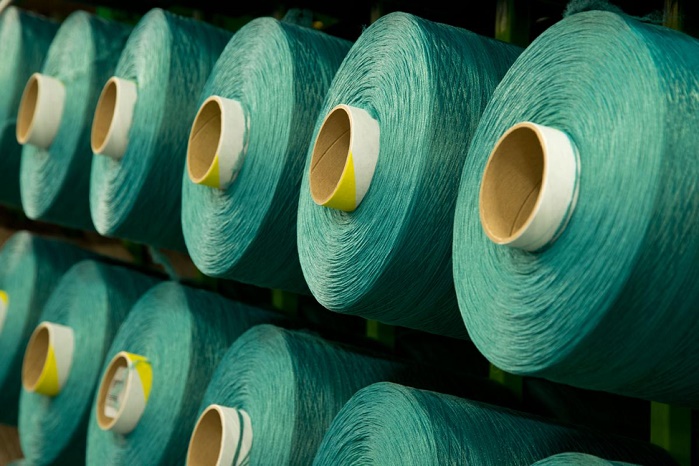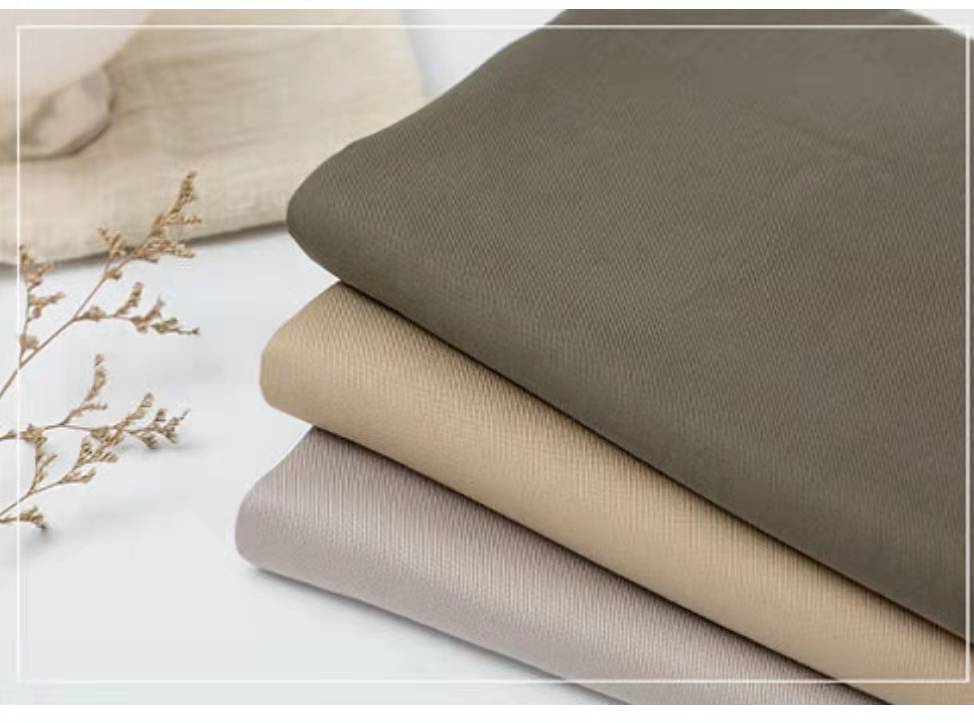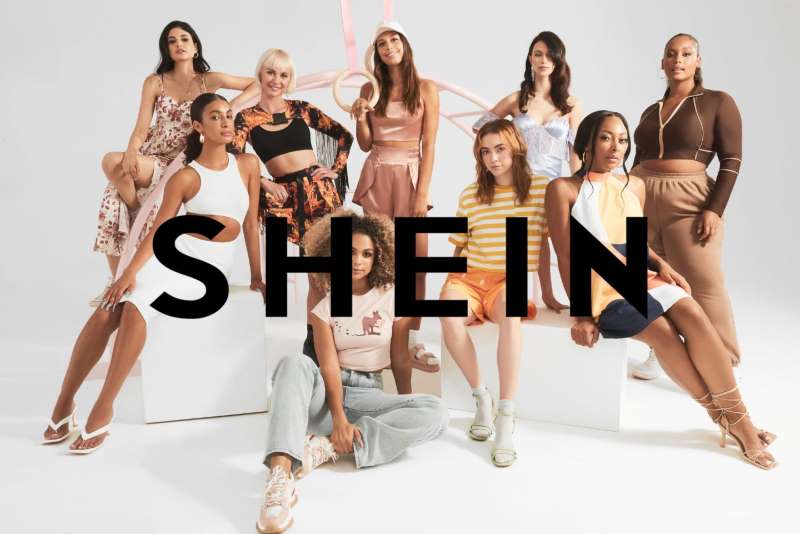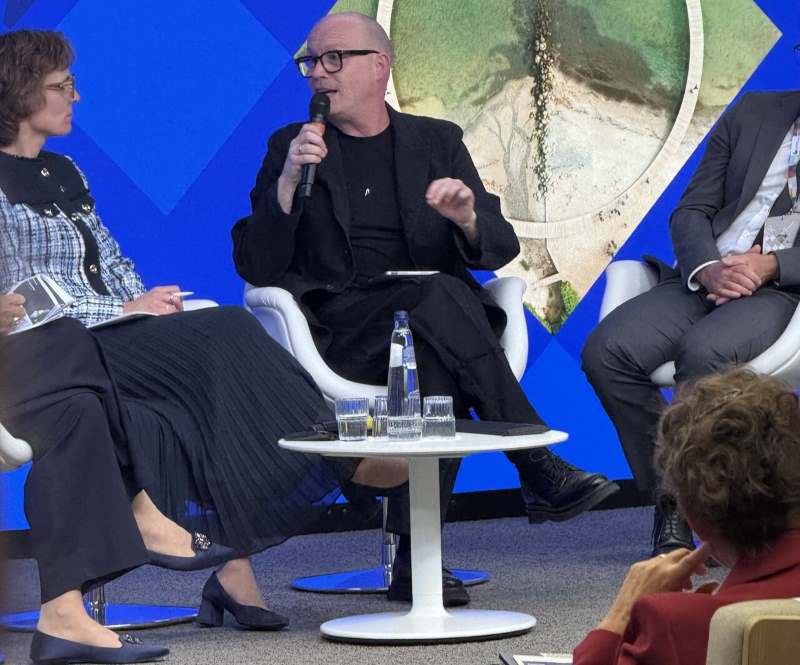FW
Everlane's Fall 2025 Campaign, ‘Laufey in Everland,’ features Grammy-winning artist Laufey and is the brand's first to be led by a celebrity. This partnership marks a new creative direction for Everlane.
Partnering with Laufey for the first talent-led campaign is a natural fit for Everlane as a brand, says Alfred Chang, CEO. Her artistry, global presence, and personal story align perfectly with the brand’s values of timeless design, individuality, and cultural relevance. Her effortless style is distinctly Everlane, and through 'Laufey in Everland,' she offers a fresh perspective on the future of Clean Luxury. Better For You.
The campaign's film, ‘Laufey in Everland,’ shows a cinematic dreamscape where Laufey goes through a portal from her home into a surreal, miniature city. The story explores the connection between timeless style, musical identity, and self-expression. In the film, Laufey invites the audience to embrace their individuality while highlighting Everlane's new Fall collection, which features pieces made for life's most important moments.
Throughout the campaign, Laufey showcases key pieces from the new collection. These items reflect the brand's core values: accessibility, thoughtful materials, and cleaner luxury. As she walks through ‘Laufey in Everland’ in the Leather T-Strap Flat, her first stop is a charming farmers market, which highlights the brand's commitment to approachable style and quality craftsmanship. From a train car, she sees rolling hills with new items like the Wrap Mini Skort, reinforcing the brand's ‘better for you’ message. Other featured pieces include the Air Alpaca Short-Sleeve Cardigan, Cashmere Handkerchief, Blazer in Tailor Twill, and the Slip Skirt in Silk Charmeuse.
In addition to the campaign, Everlane and Laufey have collaborated on an exclusive capsule collection to benefit The Laufey Foundation. The collection, which will be released on September 30, 2025, includes a Crop Zip Hoody, Cropped Crew Fleece, Wide Leg Sweatpant, and Pocket Tee Shirt in multiple colors. The collection will be available in limited quantities online and in-stores.
In a recent statement, the US cotton industry praised the new report from the Make America Healthy Again (MAHA) Commission, which calls for multi-agency research into the potential human health risks of microplastics and synthetics, particularly those from textiles. The National Cotton Council (NCC) also thanked the Trump administration for collaborating with agricultural industry stakeholders while the report was being developed.
Patrick Johnson, Chairman, NCC, says, as this topic is researched further, the Commission ensures about the potential to further underscore the inherent benefits of natural fibers in the items in our daily lives, such as clothing and bedsheets.
NCC also welcomes the Environmental Protection Agency's partnership with food and agricultural stakeholders to build confidence in the EPA’s review procedures for crop protection products, Johnson adds.
Following the Retailers Association of India's (RAI) submission regarding changes to GST rates, the Legal Metrology Department has issued a notification allowing for revised Maximum Retail Prices (MRPs) to be displayed on unsold stock. The new GST rates will go into effect on September 22, 2025.
RAI, which represents 14,000 member establishments and nearly 700,000 retail stores, wrote to the Department of Legal Metrology about the recent implementation of GST 2.0. The new rates require adjustments to the MRP of many pre-packaged goods that are already in stock.
RAI is the unified voice of Indian retailers. The organization works with stakeholders to help the modern retail industry grow. RAI actively engages with all levels of government to support employment, promote retail investments, enhance consumer choice, and strengthen industry
The nova-Institute is organizing the Renewable Materials Conference from September 22-24, 2025, in Siegburg/Cologne, Germany, and online. The event will showcase pioneering solutions and innovations for replacing fossil carbon with biomass, CO₂ utilization, and recycling.
The conference will feature a high-level panel discussion on September 22, 2025, titled, ‘The Future of the Chemical Industry in Europe: Defossilised and Competitive - How Can This Work?’
The final program includes 75 presentations and speakers, 20 panel discussions, 14 interactive workshops. four in-depth articles on topics such as ‘Fossil Fuel Trap’ and ‘Global Bio-based Polymer Market,’ introductions of six nominees for the Innovation Award, over 30 exclusive booths and 21 posters
Organized by the Hong Kong Trade Development Council (HKTDC) and sponsored by the Cultural and Creative Industries Development Agency (CCIDA), Hong Kong’s premier fashion event, Centrestage closed its 10th edition on a high note.
Held on an unprecedented scale, the four-day event attracted over 260 brands from 25 countries and regions and more than 10,000 buyers from 91 countries and regions. Notably, buyer participation from the UK, Mainland China, India, and Indonesia saw a significant increase, underscoring Hong Kong’s growing influence as a fashion hub and a center for East-West cultural exchange. Concurrent fashion event, Salon de Time, also contributed to the success, with a combined total of over 19,000 public visits, helping exhibitors expand their customer base and supporting the creative sector.
Highlighting the fair’s evolution over the years, Sophia Chong, Deputy Executive Director, HKTDC, states, over the past decade, Centrestage has become an essential trade and exchange platform for local, Asian, and international fashion brands. This year’s event set new records for scale and international participation, featuring renowned brands like Saul Nash (UK), HENRIK Vibskov (Denmark), and The Nerdys (Japan) for the first time. The fair also attracted top-tier buyers from around the world, including Machine-A (UK), Zalora (Indonesia), and Daimaru Matsuzakaya Department Stores (Japan).
An optimistic outlook
Interviewing over 400 exhibitors and buyers, a survey conducted by the HKTDC during the fair, revealed a positive outlook for the industry. According to this survey, 56 per cent of respondents anticipate sales to grow in the next 12 to 24 months, with an additional 40 per cent expecting sales to remain steady. While 44 per cent respondents identified fluctuations in the global economy and 40 per cent cited intense competition as key challenges, around 38 per cent saw the greatest opportunities in the rising demand from emerging markets.
The fair showcased key trends, with fashion accessories once again identified as a major growth area. The newly launched Accessories zone was a direct response to this market demand, as 36 per cent of respondents saw accessories as having the highest growth potential.
Focus on cross-cultural craftsmanship
Featuring as the partner country for the first time, the United Kingdom presented 16 highly creative brands and emerging designers. In collaboration with the JCA-London Fashion Academy, the UK Pavilion highlighted sustainable concepts and innovative British design.
A major theme of the event was the fusion of traditional techniques with modern design. Internationally acclaimed couturier Guo Pei unveiled her entirely hand-crafted collection, ‘Gilternity: An Everlasting Radiance.’ Additionally, designers from diverse cultural backgrounds showcased works blending traditional techniques like embroidery and tie-dye. This included brands like Isabelle C from Hong Kong, which uses the Kesi silk tapestry technique, and Yu Kwa from Macao, which incorporates intangible cultural heritage in its designs.
Launchpad for emerging talent
In a show of global appeal, Danish showroom Vald Showroom and its featured brand, Henrik Vibskov, expressed excitement about exploring new Asian markets. Imellda Ho, a Hong Kong designer specializing in custom hats, praised the HKTDC for its international vision and hands-on support, which she called ‘irreplaceable’ for independent brands.
The fair also served as a launchpad for emerging talent. The Fashionally platform showcased new collections from brands like Marcch and Lapeewee, while the Redress Design Award 2025 honored sustainable fashion designers, with the championship title jointly awarded to Carla Zhang and Hugo Dumas. The event's success reaffirms Hong Kong's position as a dynamic and influential hub in the global fashion industry.

The global fashion industry is facing a sobering contradiction. Even as some of the world’s largest apparel brands proudly champion their use of recycled polyester, the material’s overall share in global production is shrinking. A new analysis reveals that virgin polyester’s relentless growth largely due to the rise of ultra-fast fashion is eclipsing the sustainability progress made by industry leaders.
Between 2019 and 2023, global polyester production grew from 57.7 million tonnes to 71.1 million tonnes, reveals Textile Exchange and Maia Research study. Yet, paradoxically, the share of recycled polyester in this growing pool fell from 13.7 per cent to 12.5 per cent. In simple terms, recycled polyester is growing, but virgin polyester is growing faster and the sustainability balance is tilting backward.
Polyester at a crossroads
Polyester remains the backbone of fashion’s supply chain, accounting for over 54 per cent of global fiber production. Its appeal is clear: affordability, versatility, and durability. However, polyester is also derived from fossil fuels, making it one of fashion’s largest contributors to global carbon emissions.
The shift toward recycled polyester (rPET), mainly sourced from post-consumer PET bottles, was seen as a milestone in reducing dependence on virgin plastics. Yet, the latest data suggests that these efforts are not keeping pace with consumption. “Recycling is no longer enough if virgin fiber growth outpaces it. Without regulatory guardrails, fast fashion will always default to the cheaper option,” says Claire Bergkamp, CEO, Textile Exchange.
Leaders vs. laggards, it’s a divided industry
While global averages paint a grim picture, some brands have shown remarkable progress. Large, established brands have embraced recycled polyester, due to consumer demand and corporate sustainability goals. Companies like Adidas, H&M, and Lululemon have been highlighted for their successful adoption rates of 99.3 per cent, 94 per cent, and 61 per cent respectively. Their commitment has spurred innovation, with new technologies like chemical recycling emerging to improve the quality and consistency of recycled fibers. For example, Indorama Ventures has partnered with other companies to use CO₂-derived materials for new polyester fibers, while others are developing methods to recycle marine waste.
However, the progress of these leaders is being undone by the massive scale and low-cost model of fast fashion. As the Apparel Impact Institute's ‘Taking Stock’ report notes, virgin polyester is cheaper to produce than its recycled counterpart. With no mandates in place to require recycled content, instant fashion players, who prioritize speed and low price, are able to ramp up their use of the cheaper virgin fibers without consequence. This creates a competitive disadvantage for brands that invest more in sustainable materials.
Table: Recycled polyester adoption by leading brands (2024)
|
Brand |
Share of recycled polyester in materials |
Important initiatives |
|
Adidas |
99.30% |
"End Plastic Waste" campaign, investments in chemical recycling and textile-to-textile recycling. |
|
H&M |
94% |
Circular Design strategy, partnership with Syre for textile-to-textile recycling, and a goal to be 100% recycled or sustainably sourced by 2030. |
|
Lululemon |
61% |
rPET-based activewear lines, investment in plant-based fibers, and a multi-year partnership with Samsara Eco for enzymatically recycled materials. |
|
Indorama Ventures (Supplier) |
N/A |
Leading global producer of rPET, with innovations including CO₂-derived polyester and marine waste recycling. |
These leaders are proving that large-scale adoption is possible, but their progress is undermined by the low-cost, high-speed fast fashion model, where the economics are starkly different. Virgin polyester remains significantly cheaper to produce than recycled alternatives, particularly in regions with low fossil fuel costs and limited regulation. This enables ultra-fast fashion players to flood the market with inexpensive garments, free from the costs of sustainability investments.
Market dynamics
While both virgin and recycled polyester markets are growing, the disparity in absolute numbers is striking. Virgin polyester will add over $50 billion in new market value by 2030, compared to only $10.6 billion for recycled polyester.
Table: Polyester market outlook
Metric 2024 Value (USD) 2030 Projected Value (USD) Source Global Polyester Fiber Market Size $77.07 billion $129.97 billion Fortune Business Insights Global Recycled Polyester Market Size $15.52 billion $26.18 billion Grand View Research
Sustainability leaders argue that voluntary commitments are insufficient in the face of an expanding fast-fashion ecosystem. Calls are growing for regulatory frameworks that would make sustainability a baseline rather than an exception.
For example, the European Union’s Strategy for Sustainable and Circular Textiles is widely regarded as a pioneering approach. The provisions include:
Mandatory Extended Producer Responsibility (EPR): Brands must finance collection, sorting, and recycling of textiles.
Eco-design rules: Setting minimum recycled content thresholds and durability requirements.
Ban on destroying unsold stock: Forcing companies to reuse, recycle, or donate unsold goods.
By shifting costs onto all market players equally, the EU hopes to eliminate the competitive disadvantage faced by sustainability leaders. “Circularity will only scale when all companies share the same obligations. Policies like EPR are critical to level the playing field,” notes Katrin Ley, Managing Director, Fashion for Good.
India’s position as an emerging player
India, one of the world’s largest polyester producers, plays a dual role in this paradox. On one hand, it houses some of the world’s largest rPET manufacturers like Reliance Industries, which has invested heavily in recycling PET bottles into textiles. On the other, its fast-growing domestic fast fashion market risks deepening the virgin polyester problem. Without policy mandates similar to the EU, Indian producers and brands may find themselves caught between global sustainability expectations and local cost pressures.
What lies ahead?
The industry now stands at a crossroads. If virgin polyester continues to outpace recycling, the environmental costs will be staggering. Polyester already accounts for nearly 32 per cent of the fashion industry’s greenhouse gas emissions, and unchecked growth could derail global decarbonization targets. However, with policy support, technological innovation, and consumer awareness, recycled polyester could become more than just a niche solution. For now, the paradox remains: progress by leaders, erased by the scale of laggards. Until systemic interventions take hold, the fabric of fashion’s future risks being woven with more fossil fuels than circular fibers.
Stella McCartney has appointed Tom Mendenhall its new CEO, bringing on a seasoned executive with extensive experience at top luxury brands, including Ralph Lauren, Tom Ford, and Gucci.
Mendenhall takes over from Amandine Ohayon, who is stepping down from her role after nearly two years. Ohayon will remain with the company for a period to advise during the leadership transition.
Mendenhall joins the brand at a pivotal moment. While Stella McCartney is one of Britain’s most celebrated designer labels and a pioneer in sustainable fashion, it remains relatively small compared to other global brands. Its most recent financial results for 2023 showed the company was still operating at a loss. Earlier this year, McCartney herself bought back the minority stake held by French luxury conglomerate LVMH, five years after LVMH first invested in the business.
As the company sets its sights on future growth, Mendenhall will be tasked with steering the brand forward while upholding its core ethical values. He'll also be forging a close working relationship with the designer herself.
Before this role, Mendenhall served as president of the Polo and Double RL brands at Ralph Lauren. His background also includes roles as COO at Tom Ford, global merchandising director at Gucci, and senior vice president at Abercrombie & Fitch.
Stella McCartney states, Mendenhall shares her vision for the brand and the ethical values that are part of the brand’s DNA. His extensive experience in all aspects of luxury fashion will be invaluable in driving the business forward, she adds.
In turn, Mendenhall called the label a powerful one ‘led by a strong and compassionate woman,’ and said he looks forward to working with McCartney and her global team.
Held from September 2-3, 2025 at the Business Design Centre, the London Textile Fair (TLTF) attracted over 320 exhibitors and 3,587 visitors.
Exhibitors from 20 countries - including strong representation from Turkey, the UK, China, Italy, France, Portugal, India, and Taiwan - showcased a diverse range of collections at the show. In particular, the Taiwan and China Pavilions presented a wide array of high-quality textiles, accessories, and garments, emphasizing advanced manufacturing and eco-friendly solutions.
The fair's collections were heavily focused on fabrics, which made up 80 per cent of the displays. The remaining exhibitors were divided among fashion accessories (6 per cent), vintage and print design (7 per cent), and garments (7 per cent), showcasing the event’s comprehensive approach to the entire textile and fashion supply chain.
With 95 per cent of its 3,587 visitors coming from the UK, The London Textile Fair primarily drew a strong domestic audience. Industry professionals from nearly every major British fashion brand and designer were in attendance, from high-street retailers to independent boutiques. Visitors included representatives from Urban Outfitters, Allsaints, Marks & Spencer, Vivienne Westwood, Paul Smith, Next, Jigsaw, Ted Baker, etc.
Beyond the sourcing floor, the fair hosted a vibrant Trend Forum and a dynamic seminar program called ‘Design Vision.’ Curated by The Colourful, the seminars offered leading trend forecasters who shared key insights into Fall/Winter 2026/27 color, fabric innovation, and market intelligence. These sessions were well-attended by designers and buyers seeking creative inspiration for their upcoming collections.
The seminars enriched the fair by creating an interactive space for dialogue, allowing visitors to engage with speakers on the intersection of global trends with sustainability, technology, and creativity. By providing a platform for forward-thinking ideas and industry knowledge, the fair solidified its position as more than just a sourcing event.
Live social shopping brand, QVC has partnered with global fashion designer Rebecca Minkoff to debut a new, exclusive apparel line: RM Studio x Rebecca Minkoff. The capsule collection is available now on QVC.com and premiered on-air during the ‘Fri-Yay’ broadcast.
Mara Sirhal, Chief Merchandising Officer, QVC, says, the RM Studio x Rebecca Minkoff collection delivers on every level, giving shoppers exclusive access to designer pieces that adapt seamlessly to their everyday lifestyle - from day to night.
The collection features a mix of feminine and edgy designs that find a balance between structure and softness. Offering statement jackets, denim, and chunky knits, the apparel pieces are designed to invite shoppers to experiment with proportion through artful pleats, ruching, and innovative patterns. This line offers elevated wardrobe staples that are meant to move with you, flatter you, and make a statement.
QVC has a unique ability to bring designers and customers together through storytelling and connection, which made them an ideal partner for our brand, says Rebecca Minkoff. Through this collaboration, the brand distills its essence into everyday pieces and inspires women to embrace their authentic selves, all while making designer fashion more accessible than ever.
Developed in collaboration with Rachael Barnard, the Apparel Design & Manufacturing Executive for Rebecca Minkoff at Sunrise Brands, the collection is a testament to QVC’s commitment to bringing coveted brands to life through engaging, real-time storytelling.
The RM Studio x Rebecca Minkoff collection is available in sizes XXS–3X in both regular and petite, with pricing that ranges from $50–$150.
The outlook for India's apparel export sector has been downgraded from ‘Stable’ to ‘Negative’ by the credit rating agency ICRA, following a significant increase in United States tariff rates. The agency warns that this shift is expected to put a strain on export revenues in the coming fiscal year.
According to ICRA, a combination of lower export volumes and pricing pressures will likely cause industry operating margins to contract by 200–300 basis points in FY2026. Companies that are more dependent on the U.S. market are expected to feel a steeper impact. The agency projects a 6-9 per cent drop in total apparel export revenues for FY2026 if the tariffs remain in effect. This decline is expected despite a partial cushion from the U.K. Free Trade Agreement (FTA) and a potential redirection of some shipments to other destinations.
Operating profit margins are forecast to fall from approximately 10 per cent in FY2025 to around 7.5 per cent, reflecting weaker performance in the latter half of the year and reduced operational efficiency.
The United States is a critical market for India, accounting for nearly one-third of its total apparel exports and holding about a 6 per cent share of the US apparel import market. This comes as Indian exporters are already facing stiff competition from major rivals like Bangladesh and Vietnam, which has eroded India’s global market share.
The 50 per cent increase in US tariff rates, which went into effect on August 27, will directly impact the cost-competitiveness of Indian exporters. While some companies shipped products earlier than planned to get ahead of the tariff hike and boost first-half revenues for FY2026, ICRA cautioned that the full pressure of the tariffs will intensify in the second half of the year. The agency also noted that lower earnings and higher working capital needs could ultimately weaken the credit standing of apparel exporters.












